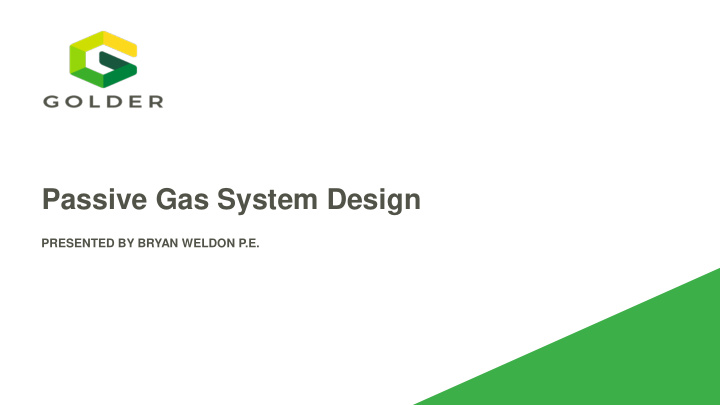



Passive Gas System Design PRESENTED BY BRYAN WELDON P.E.
Passive System Overview 01 Passive Components 02 Integrating and Upgrading 03 Questions 04 2
Passive System Overview ___ 3
Passive Gas System ___ 4
Passive Gas System • Usually not Installed until Final Cap Construction Vent GAS • Should be Designed with COLLECTION LAYER New Cell Construction • If Landfill Expands in Future, May Require Active System WASTE ___ 5
Passive Components ___ 6
Passive Components G A S C O N V E YA N C E P I P E W O R K • Installed Under the Cap • Almost Entirely Perforated/Slotted Pipework • Pipework Buries in Drainage Aggregate Pipework • Similar to Active System, Best Practice to Maintain Grade • Pipe Sizes and Vents Designed to Handle Gas Generation Rates ___ 7
Passive Components S O L A R F L A R E S • Install in Gas Vents • Localized Gas Flaring • Operate with Low Flows • Operate at Ambient Pressure or Low Vacuum • Difficult to Operate in Cold Weather Climates • Heat Pads, Insulation and Running Power Source: solar-spark.com ___ 8
Integrating and Upgrading ___ 9
Integration and Upgrading I N T E R M E D I AT E G A S V E N T I N G • Caisson Wells • Extended up as waste is filled around it • Self draining if tied into leachate drainage layer • Can connect to passive gas vents to allow deep gas extraction and migration control • Horizontal Wells • Used for intermediate venting before final cover • Can be connected to final vents ___ 10
Integrating and Upgrading C O N N E C T I N G B L O W E R T O L E A C H AT E O R PA S S I V E V E N T S • Not a Preferred Method of Gas Extraction • Need to Design Isolation Valves and Blank Flanges to Limit Air Infiltration • Consider Condensate Drainage Sumps • Use Wellhead to Regulate Flow Through Leachate Pipework ___ 11
Questions ___ 12
Recommend
More recommend